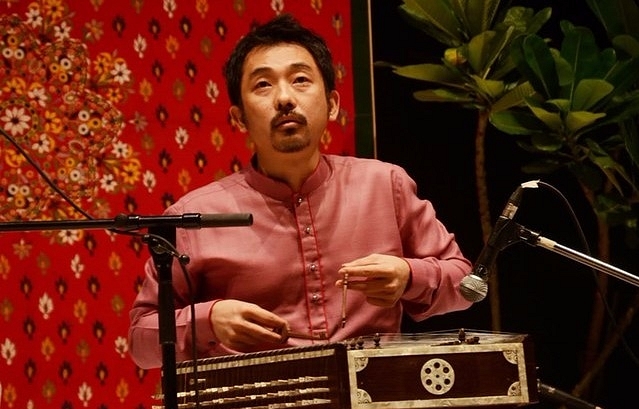Culture
How Pt Shiv Kumar Sharma Shaped My Life And Music
- Takahiro Arai, who grew up listening to pop music, developed a passion for Indian classical music after listening to Pandit Ravi Shankar and Pandit Shiv Kumar Sharma. He wants to see India and Japan work on preserving music and culture.

Takahiro Arai performs on santoor
Santoor artiste Takahiro Arai writes about his guru, lessons and practice.
My journey in Indian classical music began with ragas Sohini and Des. At 24, I heard Pandit Ravi Shankar’s sitar on a record, and at 25, Pandit Shiv Kumar Sharma’s santoor. I was mesmerised. However, I could not fully understand what was happening in their music. Coming across a new language of music opened doors to a new realisation. I was playing drums for 10 years and still could not even count the music. I was shocked. I thought I should learn this music. I found Pandit Shiv Kumar Sharma’s disciple in Japan. His name is Setsuo Miyashita. He became my first guru. Miyashita’s lessons, my practice, and a growing urge to learn Indian classical music led me to Pandit Shiv Kumar Sharma. I became his disciple. Pandit Shiv Kumar Sharma has not only taught me music, but also given me lessons on life.
I am really lucky to have got such a great and humble guru. I have been traveling with him in India and abroad since 2009. Learning, during his presence on the dais, is a precious experience. I get lessons on improvisation, on the contact and connect with the tabla artiste and audience, on preparations for concerts, and sound check. Guruji and Hariji’s (Pandit Hari Prasad Chaurasia) jugalbandi is a perfect combination and duet. They understand each other personally and it reflects in their music. Their music has left a huge impact on me. It is very important to play jugalbandi. During practice, I try to feel that I am not playing the santoor, someone else is. Guruji (Pandit Shiv Kumar Sharma) has told me that it is an easy way to understand where we are going wrong. For me, it is difficult to reproduce music on santoor even now. Guruji allowed recording of all lessons, so I can listen and repeat, and repeat.
I like listening to music of the great artistes like Ustad Amir Khan, Ustad Bade Ghulam Ali Khan, Pandit D V Paluskar, Ustad Ali Akbar Khan, Pandit Ulhas Kashalkar, Ustad Rashid Khan and Gundecha Brothers. Renowned santoor artiste Rahul Sharma is doing very well, not only in classical music, but also in fusion.
Hamsadhwani is one of my favourite ragas. It evokes romance. Playing Hamsadhwani makes me joyful. While playing the santoor, I try to make myself calm and listen to the melody coming from within me. I am constantly working to improve. Sometimes, I watch my muscles and work on the muscle movement. Coming to practice, I take up the jhala and taans in a raga for warming up, following it with aalap and jod for understanding the raga. Finally, I move to the gat and work on making tehais. Among ragas, I try to understand Megh, Bhupali and Mishra Khamaj. Tuning, I believe, is the most difficult part of playing santoor. Even after so many years of learning, I am still trying to understand the santoor and shruti. I try singing on the santoor. Currently, I am trying my best to imbibe my guru’s style. However, years later, I wish to discover new possibilities in music. I want to explore different styles.
Indian music is not very popular in Japan. When performing in Japan, I don’t explain the deeper meanings of Indian classical music to the audience. Initially, I want to let the audience enjoy Indian classical music and melodies. I understand that Indian classical music connects to spirituality deeply.
I find some similarities in Indian and Japanese music. In Japanese folk music, there are melodies similar to Raga Bhupali. Our national anthem is based on Raga Megh. Korean pop music is very popular in Japan. However, folk music from Korea is not heard much.
I am not from a musical family. My parents like listening to pop and not traditional music. I grew up listening to pop music. I like Miyuki Nakajima, a very popular singer and songwriter in my country. During my school days, I used to listen to The Yellow Monkey, a rock band. I don’t know much about Japanese traditional music. Not many people in Japan know about it. Television and radio don’t broadcast it. They broadcast only pop music and Japanese idol music. They should introduce traditional music. People in my country don’t attend concerts. They don’t want to spend money and time on concerts when they can stream music online. Japanese and Indians must preserve their music, culture and roots.
Support Swarajya's 50 Ground Reports Project & Sponsor A Story
Every general election Swarajya does a 50 ground reports project.
Aimed only at serious readers and those who appreciate the nuances of political undercurrents, the project provides a sense of India's electoral landscape. As you know, these reports are produced after considerable investment of travel, time and effort on the ground.
This time too we've kicked off the project in style and have covered over 30 constituencies already. If you're someone who appreciates such work and have enjoyed our coverage please consider sponsoring a ground report for just Rs 2999 to Rs 19,999 - it goes a long way in helping us produce more quality reportage.
You can also back this project by becoming a subscriber for as little as Rs 999 - so do click on this links and choose a plan that suits you and back us.
Click below to contribute.
Latest